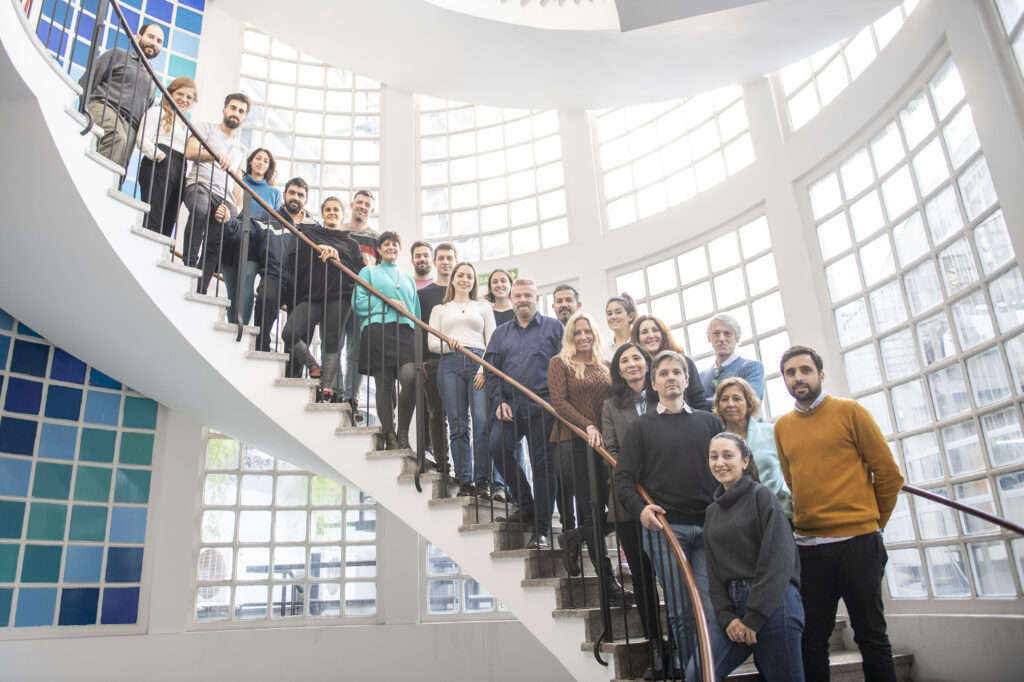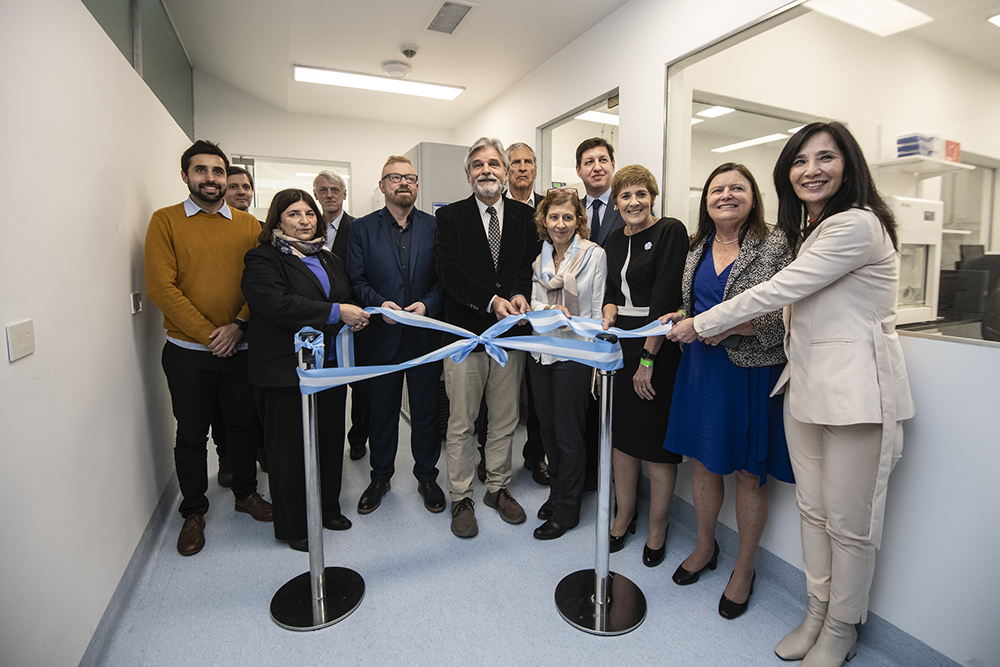A scientific career towards patients
Through the creation of a biotech company CONICET researcher Gabriel Rabinovich, with colleagues and other specialists, seeks to transform three decades of scientific discoveries into new therapeutic strategies for the treatment of cancer, autoimmune and inflammatory diseases

In 1993, while working on his PhD thesis at the National University of Córdoba (UNC), Gabriel Rabinovich, CONICET researcher and director of the Glycomedicine Laboratory of the Institute of Biology and Experimental Medicine, identified and purified a sugar-binding protein that had the particularity of silencing activated T lymphocytes, cells of the immune system responsible for attacking both pathogens and tumor cells. The molecular and functional characterization of this protein, Galectin-1 (Gal-1), was the subject of his PhD thesis, directed by Clelia Riera at the Faculty of Chemical Sciences of the UNC. The antibodies that made it possible to identify this protein had been developed in the laboratory of Carlos Landa, with whom Rabinovich had worked in the last year of his career.
Thirty years after that discovery in his native Córdoba, and after multiple investigations that allowed to deepen the knowledge about the key role of Gal-1 in the regulation of the immune system in different physiological and pathological scenarios, Rabinovich -who is also full professor of Immunology at the Faculty of Exact and Natural Sciences of the University of Buenos Aires (FCEN, UBA)- created GALTEC, together with colleagues from CONICET and professionals from different disciplines. GALTEC is a biotech company whose main objective is to develop therapeutic products that can modulate the activity of Gal-1, increase or block its expression (“turn it on” or “turn it off”), with the aim of manipulating the functioning of the immune system against different diseases.
Increasing Gal-1 expression could be necessary for the development of autoimmune diseases – such as multiple sclerosis, rheumatoid arthritis or diabetes – in which, as various laboratory studies have shown, a deficiency in this protein could cause the tolerogenic circuits to become dysregulated and the immune system to attack the body’s own functional tissues, with significant damage to the patient’s health and quality of life. Blocking Gal-1, on the other hand, could be necessary for certain cancers, in which it has been proven that the high expression of Gal-1 helps tumors to escape the response of the immune system’s T lymphocytes, as well as to create blood vessels that allow them to supply themselves with nutrients and oxygen in order to grow and spread.
Rabinovich, who joined CONICET’s Scientific and Technological Research Career at the beginning of 2002 after a period as a postdoctoral fellow, likes to associate Gal-1 with Dr Jekyll and Mr Hyde, the character from Robert Louis Stevenson’s novel, since, he says, “sometimes it plays the role of villain, when it helps tumors to evade the immune system’s response, and sometimes that of heroin, by preventing the appearance of autoimmune diseases”.
Like many researchers, Rabinovich always wanted his scientific work to help improve the lives of patients. In this way, the creation of GALTEC is an important step towards the realization of that long-held aspiration. However, he always considered that the only way to achieve this goal was to first carry out rigorous fundamental research, which would serve as a basis for the development of new therapeutic strategies. On this path, Rabinovich, together with his work teams, has made a long journey that has involved important achievements and numerous scientific publications, many of them in highly recognized journals.

Some scientific findings from basic research
One of the first important findings regarding the role of Gal-1 in autoimmune diseases was the discovery that administration of this protein to mice with arthritis could reverse symptoms of the disease by eliminating activated T lymphocytes. This study was published in the Journal of Experimental Medicine and highlighted in an article in the journal Nature. Rabinovich recalls with emotion how they managed to get mice that could not walk to walk again.
Rabinovich’s hypothesis that if Gal-1 played a beneficial role in the development of autoimmune diseases, by suppressing T lymphocytes attacking functional tissues, it should then play a detrimental role in cancer, by shielding the tumor from the immune system response, was verified in a paper that was on the cover of Cancer Cell. “The sweet kiss of death: Galectin-1 and tumor immune escape”, pointed out that cover, alluding to the fact that Gal-1 is a protein that binds to sugars, which helps tumors to escape the immune response.
In this work, of which Rabinovich was the director, he demonstrated that inhibition of the gene encoding Gal-1 resulted in increased immune system rejection of the tumor by T cells. “When Gal-1 was inhibited, a large number of T lymphocytes appeared that attacked and eliminated the tumor,” says Rabinovich. Thus, the hypothesis that, by negatively regulating the expression and survival of activated T lymphocytes, Gal-1 could play diverse and opposing roles against different diseases was confirmed. For this study, in in vitro and in vivo experiments were performed and patient samples were used.
Over the following years, different investigations led by Rabinovich increased the knowledge about the impact that the interaction between Gal-1 and its receptors have on key components of the immune response, such as pathogenic T lymphocytes (Th1 and Th17), dendritic cells and regulatory cells. In turn, this paradigm could be demonstrated at the maternal-fetal interface (during pregnancy) and published in the journal Nature Medicine.
In early 2014, Rabinovich and his team published a paper that would be the cover of Cell, one of the most prestigious international scientific journals. The study proved in experimental models that Gal-1, in addition to helping different types of cancers escape the immune response, creates blood vessels (known as angiogenesis) that allow tumors to obtain oxygen and nutrients to grow and metastasize. The paper highlighted that this role of Gal-1 could be the reason why certain anti-angiogenic cancer treatments that target Vascular Endothelial Growth Factor (VEGF) blockade were ineffective. Tests in experimental models also showed that administration of an anti-Gal-1 monoclonal antibody successfully counteracted resistance to VEGF blockade and reduced tumor growth. “This study was very important for us because we were able to reveal a new role for Gal-1 in cancer, in addition to the immunosuppressive role we already knew,” says the researcher. Marta Toscano, Juan Ilarregui, Diego Croci, Mariana Salatino, Tomás Dalotto Moreno, Natalia Rubinstein and Santiago Méndez Huergo were involved in this work.
Recently, in 2023, the team published a study in Proceedings of the National Academy of Sciences (PNAS) in which they demonstrated the clinical relevance of the work published in Cell. The new study, which featured Nadia Bannoud, Juan Stupirski and Alejandro Cagnoni, showed, based on samples from melanoma patients, that Gal-1 can indeed promote angiogenesis upon VEGF blockade. In addition, an entirely human anti-Gal-1 monoclonal antibody was presented that was able to inhibit, in in vitro cellular models, angiogenesis driven by Gal-1-rich plasma from oncology patients treated with a VEGF inhibitor.
In early 2020, shortly before the start of the pandemic, in a paper published in PNAS, Rabinovich and his team concluded that Gal-1 is a hierarchical regulator of the immune system and functions as an inhibitory check-point that prevents the spontaneous onset of age-related autoimmune diseases. For this study, the researchers allowed Gal-1-deficient mice to age and observed that, with age, these animals spontaneously developed a phenotype similar to Sjögren’s syndrome, an autoimmune disease characterized by inflammation of the salivary glands. “That, with age, mice without Gal-1 developed an autoimmune disease allowed us to conclude that Gal-1 has a hierarchical homeostatic role,” says Rabinovich. This research was co-directed by Marta Toscano and had Verónica Martínez Allo as first author. In addition to this work, other projects in the laboratory, led by Sebastián Maller, Luciano Morosi and Nicolás Pinto, had demonstrated the role of galectins in the regulation of the immune response in different tissues, such as intestinal tissue, adipose tissue and skin.

GALTEC: closer and closer to patients
After three decades of basic research that determined the importance of Gal-1 in different pathologies, as well as the therapeutic efficacy of blocking or stimulating its expression in models of different diseases, Rabinovich, together with colleagues and collaborators, decided that it was time to focus on the development of therapeutic strategies. With these objectives in mind, among others, today they formally founded GALTEC. They have already developed and presented candidates for Gal-1 inhibition. Although the first anti-Gal-1 monoclonal antibodies they used in different investigations were murine in nature, in the study published in PNAS this year they have already used, tested and characterized a human antibody.
“This monoclonal antibody can block Gal-1 and inhibit its angiogenic and immunosuppressive activity, and has a high degree of specificity that allows it to recognize Gal-1 but not other members of the same family of proteins,” says Rabinovich. Two of GALTEC’s co-founders, Juan Manuel Pérez Sáez and Pablo Hockl, CONICET researcher and support staff at IBYME, respectively, were involved in this development. Alejandro Cagnoni, a CONICET researcher at IBYME and scientific advisor to the company, was responsible for the functional and biophysical characterization of the neutralizing monoclonal antibody.
To be able to develop a variant of Gal-1 that, when administered, compensates for its deficiency has been complex -according to the word of the specialists-. However, according to the researcher, thanks to the contribution of experts in chemistry, modeling and clinical research, such as Cagnoni himself, Santiago Méndez Huergo, Santiago Di Lellay and Karina Mariño, a researcher at CONICET and advisor to GALTEC, we are on the way to overcoming these problems. This work has been carried out in collaboration with Argentine references such as Darío Estrin and Julio Caramelo.
“Over three decades, after identifying the presence of Gal-1 in the immune system, we were able to determine many of the functions of this protein in different pathological and physiological scenarios. The creation of GALTEC’s main mission is to transform all these discoveries into technologies and products that can impact society and improve people’s lives,” concludes Rabinovich.
